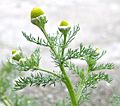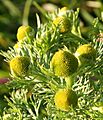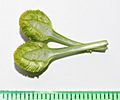Pineappleweed facts for kids
Quick facts for kids Pineappleweed |
|
|---|---|
 |
|
| Pineappleweed | |
| Scientific classification | |
| Synonyms | |
|
Artemisia matricarioides auct. |
Pineappleweed (scientific name: Matricaria discoidea) is a common plant found in many places around the world. It gets its name because its flowers smell a bit like pineapple when you crush them! This plant is also known as wild chamomile or disc mayweed. It belongs to the daisy family, called Asteraceae.
People can eat the flowers and leaves of Pineappleweed. They are sometimes used in salads or to make a special herbal tea. For a long time, people have also used this plant as a natural medicine to help with things like tummy aches, fevers, and other health problems.
Contents
What Pineappleweed Looks Like
Pineappleweed plants usually grow from about 2 to 16 inches (5 to 40 cm) tall. Their flowers are shaped like small cones. These cone-shaped flowers are yellowish-green and packed tightly together. Unlike some other flowers, they do not have the typical "petals" that stick out.
The leaves of the plant are deeply cut, almost like feathers. They also have a sweet smell when you crush them. You can usually see these flowers blooming from March to September.
Where Pineappleweed Grows
Pineappleweed grows very well in places where the ground has been disturbed. This includes areas with poor or packed-down soil. You can often spot it blooming on footpaths, roadsides, and similar spots in the spring and early summer.
In North America, this plant can be found from central Alaska all the way down to California. It also grows across the continent to Nova Scotia and Newfoundland. It has also become very common in Britain.
Native Regions
Pineappleweed is originally from parts of Asia.
- Russian Far East: This includes areas like Amur Oblast, Kamchatka Peninsula, and Sakhalin.
- Eastern Asia: It is also native to Hokkaido in Japan.
How People Use Pineappleweed
The green parts of the plant can be washed and eaten. Both the flowers and the whole plant can be steeped in hot water to make a tea. Many people describe this tea as excellent.
Pineappleweed has also been used for its medicinal qualities. People have used it to help with upset stomachs, infected sores, and fevers.
Gallery
See also
 In Spanish: Matricaria discoidea para niños
In Spanish: Matricaria discoidea para niños






